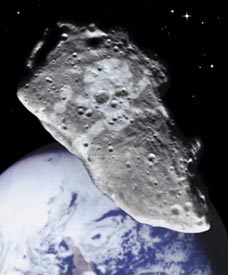
Astronomers are debating how to best inform the public about the risks that near-Earth asteroids pose to our planet.
S&T illustration by Steven Simpson.
Reports of possible impacts by comets or asteroids are not exactly a new thing. Edmond Halley, long before the comet that bears his name made its first predicted return, suggested that a comet might eventually strike Earth with possibly devastating results.
It wouldn't be surprising if, back in 1690, a few press reports blew Halley's warning way out of proportion, and astronomers worried that their credibility would be undermined as a result. That's what regularly happens nowadays. Faced with this problem, some researchers attending this week's Workshop on Scientific Requirements for Mitigation of Hazardous Comets and Asteroids presented ideas about how to improve public communications surrounding the increasingly high-profile impact prediction process.
Today's astronomers use numerical yardsticks to assess impact risk. The Torino Scale, which was designed with the general public in mind, ranks threatening near-Earth objects on a zero-to-ten basis. A value of zero means that the risk of a certain object hitting Earth is lower than that from a random strike within the same time frame by an unknown object of comparable mass. Higher values represent both a more likely probability of impact and a more severe outcome.
By contrast, the Palermo Scale was created for astronomers' use. It assigns zero to any object that has the same probability of hitting Earth in a given time period that a random object would. But it also assigns negative values to objects that pose less risk than random impacts. And its rankings are assigned differently too, with no distinction between small impacts and big ones.
Clark Chapman (Southwest Research Institute) and Brendan Mulligan (Queen's University, Canada) investigated a wide variety of hazard scales that have been used to communicate everything from hurricanes and forest fires to nuclear war and terrorism, most of which, like the Torino, use simple, linear scales of 1 to 5 or 10. Chapman says that with some modification, the Torino Scale for impact risk seems to hold up well, and he suggested it should be used consistently in communicating with the public about new possibly-hazardous asteroids. However, he says, some of the descriptions
originally given for each number on the scale need to be revised.
For example, he points out that 1 on the Torino scale classifies an object that "merit careful monitoring." That can be misleading to the public, he says, since they are obviously not expected to do the monitoring; most hazard
scales are worded in terms of what the general public should do. However, he says, astronomers should avoid public references to the Palermo Scale — whose usage figured prominently in the reports six weeks ago about a low-probability possible impact in 2019 by asteroid NT7.
Some of those reports, Chapman says, were "confusing and inappropriate," since they stressed the fact that this was the first object ever to get a positive, greater-than-zero Palermo rating. Since the scale was barely a year old, he says, that's "like calling the Queens air crash last fall the worst transportation disaster of the century, when the century was barely a year old!"
David Morrison (NASA/Ames Research Center) says that on the one hand, such reports do help raise public awareness of the issue, but they also have "demeaned the credibility of astronomers in the public's eye." While astronomers should not suppress information, he suggests, they should make sure that a good, responsible report of the facts is quickly available on the Internet, even "in a few sentences, to give our view." But he criticizes recent suggestions for a military-run warning center for asteroid impact predictions. Because real, substantiated warnings of a serious asteroid danger will be so rare — perhaps one every 50 to 100 years — "this is not a credible option," he says.
Duncan Steel (University of Salford, United Kingdom) suggested his own analogy to help the public understand the risk and how to put it in perspective: comparing the asteroid threat to the risk of cancer. For any individual, the risk is low on any given day, but must be taken seriously; early detection is crucial — if one is detected, suddenly the high cost of mitigation becomes irrelevant. And if it is detected early enough, the treatment can be highly effective.
 0
0
Comments
You must be logged in to post a comment.